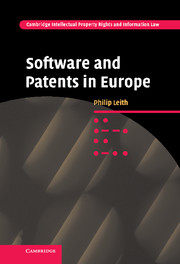Book contents
- Frontmatter
- Contents
- List of figures
- Introduction
- 1 Software as machine
- 2 Software as software
- 3 Policy arguments
- 4 Software patent examination
- 5 Holding the line: algorithms, business methods and other computing ogres
- 6 The third way: between patent and copyright?
- 7 Conclusion: dealing with and harmonising ‘radical’ technologies
- Index
- Cambridge Intellectual Property and Information Law
4 - Software patent examination
Published online by Cambridge University Press: 22 July 2009
- Frontmatter
- Contents
- List of figures
- Introduction
- 1 Software as machine
- 2 Software as software
- 3 Policy arguments
- 4 Software patent examination
- 5 Holding the line: algorithms, business methods and other computing ogres
- 6 The third way: between patent and copyright?
- 7 Conclusion: dealing with and harmonising ‘radical’ technologies
- Index
- Cambridge Intellectual Property and Information Law
Summary
When I have a new trainee, on his first day I tell him … two things. The first is you do exactly the same when writing a story – you collect the facts and you must give them a structure, the structure of the claims. And if you are a good author, then that is the first requirement. The technical element you can learn from the person who comes to you – there is no need to know anything about the topic you are working on. But then when preparing a case you have to convince the examiner of the merits of the invention. And that is not a point of technical ability but of psychology.
Introduction
Whilst amongst a group of postgraduate IP students, I made a statement which I thought was relatively non-controversial: that getting patent protection was not too difficult. The law students, almost as one, let out a groan of dispute which clearly suggested that they considered me wrong. Is this a view that most lawyers hold? Perhaps more comfortable with the substantive law of patenting rather than the technology being discussed – noting the seeming highly technical nature of the patent specifications and concluding that it must ‘all be very difficult’ indeed? It is not clear why the students viewed patent examination as such a significant hurdle to overcome.
- Type
- Chapter
- Information
- Software and Patents in Europe , pp. 102 - 134Publisher: Cambridge University PressPrint publication year: 2007



